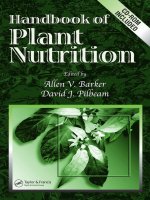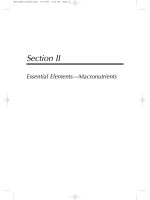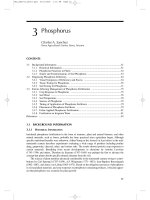Chap 13 plant nutrition lec
Bạn đang xem bản rút gọn của tài liệu. Xem và tải ngay bản đầy đủ của tài liệu tại đây (6.6 MB, 44 trang )
Chap 13. Plant Nutrition
1. Plant Nutrients
Macronutrients
Micronutrients
2. Chemical Fertilizers
Commercial Analysis
Elemental Analysis
3. Fertilizer Concentration Calculations
ppm
mM
Meq/liter
4. Fertilizer Application
Preplant Application
Top Dressing
Liquid Feeding
1. Essential Nutrietns of Plants
Element
Chemical
symbol
Atomic
weight
Ionic forms
Absorbed by plants
Approximate dry
____ concentration_____
Mccronutrients
Nitrogen
Phosphorus
Potassium
Magnesium
Sulfur
Calcium
N
P
K
Mg
S
Ca
14.01
30.98
39.10
24.32
32.07
40.08
NO3-, NH4+
PO43-, HPO42-, H2PO4K+
Mg2+
SO42Ca2+
Fe
Mn
Zn
Cu
B
Mo
Cl
55.85
54.94
65.38
63.54
10.82
95.95
35.46
Fe2+, Fe3+
Mn2+
Zn2+
Cu2+
BO32-, B4O72MoO42Cl-
4.0 %
0.5 %
4.0 %
0.5 %
0.5 %
1.0 %
Micronutrients
Iron
Manganese
Zinc
Copper
Boron
Molybdenum
Chlorine
200 ppm
200 ppm
30 ppm
10 ppm
60 ppm
2 ppm
3000 ppm
Essential But Not Applied
Carbon
C
12.01
CO2
40 %
Hydrogen
H
1.01
H2O
6%
Oxygen
O
16.00
O2, H2O
40 %
________________________________________________________________
Plant tissues also contain other elements (Na, Se, Co, Si, Rb, Sr, F, I) which are not
needed for the normal growth and development.
2. Macronutrients
a. Nitrogen (N)
1) Soil Nitrogen Cycle
A. Nitrogen (N)
1) Soil Nitrogen Cycle
a) Nitrogen Fixation
-Transformation of atmospheric N to nitrogen forms available to
plants
- Mediated by N-fixing bacteria:
Rhizobium (symbiotic) found in legumes (bean, soybean)
Azotobacter (non-symbiotic bacteria)
b) Soil Nitrification
- Decomposition of organic matter into ammonium and nitrate
- Mediated by ammonifying and nitrifying bacteria
Ammonifying bacteria
(Actinomycetes)
Plant residue
(Protein, aa, etc)
→
Nitrifying bacteria
(Nitrosomonas)
NH4+
Ammonium
→
(Nitrobacter)
NO2 →
NO3-
Nitrite
Nitrate
2) N Functions in Plants
- Component of proteins, enzymes, amino acids, nucleic acids, chlorophyll
- C/N ratio (Carbohydrate: Nitrogen ratio)
High C/N ratio → Plants become more reproductive
Low C/N ratio → Plants become more vegetative
- Transamination
NO3- → NH2 → Glutamic acid → Other amino acids (a.a.) → Protein
Enzymes
- Essential for fast growth, green color
3) Deficiency and Toxicity Symptoms
Deficiency: - Reduced growth
- Yellowing of old leaves
Toxicity (excess): - Shoot elongation
- Dark leaves, succulence
4) Fertilizers
- Ammonium nitrate (NH4NO3)
Calcium nitrate [Ca(NO3)2]
Potassium nitrate (KNO3)
Urea [CO(NH2)2]
- Most plants prefer 50:50 NH4+ : NO3NH4+-form of N → lowers soil pH
NO3--form of N → raises soil pH
- Organic fertilizers (manure, plant residue) – slow acting
- N can be applied foliarly
Nitrogen (N) Deficiency Symptoms
Yellowing of mature lower leaves- nitrogen
is highly mobile in plants
B. Phosphorus (P)
1) Soil Relations
- Mineral apatite [Ca5F(PO4)3]
- Relatively stable in soil
- Has a low mobility (top dressing not effective)
2) Plant Functions
- Component of nucleic acid (DNA, RNA), phospholipids, coenzymes,
high-energy phosphate bonds (ADP, ATP)
- Seeds are high in P
3) Deficiency and Toxicity
- P is mobile in plant tissues (Deficiency occurs in older leaves)
- Deficiency: dark, purplish color on older leaves
- Excess P: causes deficiency symptoms of Zn, Cu, Fe, Mn
4) Fertilizers
- Superphosphates (may contain F)
Single superphosphate (8.6% P): CaH4(PO4)2
Triple superphosphate (20% P): CaH4(PO4)2
- Ammonium phosphate:
(NH4)2PO4, NH4HPO4
- Bone meal
- Available forms: PO43-, HPO42-, H2PO4P absorption influenced by pH
Influence of pH on different forms of phosphorus (P)
C. Potassium (K)
1) Soil Relations
- Present in large amounts in mineral soil
- Low in organic soils
2) Plant Functions
- Activator of many enzymes
- Regulation of water movement across membranes and through stomata
(Guard cell functions)
3) Deficiency and Toxicity
- Deficiency:
Leaf margin necrosis and browning
- Toxicity:
Older leaves are more affected
Leaf tip and marginal necrosis
4) Fertilizers
- Potassium chloride (KCl)- murate of potash
- Potassium sulfate (K2SO4)
- Potassium nitrate (KNO3)
Leaf Margin Necrosis in Poinsettia
Potassium (K) Deficiency
Macronutrients N, P, K Deficiencies
Leaf Lettuce
Control
Macronutrient Deficiencies
Beans
D. Calcium (Ca)
1) Soil Relations
- Present in large quantities in earth’s surface (~1% in US top soils)
- Influences availability of other ions from soil
2) Plant Functions
- Component of cell wall
- Involved in cell membrane function
- Largely present as calcium pectate in meddle lamela
Calcium pectate is immobile in plant tissues
3) Deficiency and Toxicity
- Deficiency symptoms in young leaves and new shoots (Ca is immobile)
Stunted growth, leaf distortion, necrotic spots, shoot tip death
Blossom-end rot in tomato
- No Ca toxicity symptoms have been observed
4) Fertilizers
- Agricultural meal (finely ground CaCO3·MgCO3)
- Lime (CaCO3), Gypsum (CaSO4)
- Superphosphate
- Bone meal-organic P source
Blossom End Rot of Tomato
Calcium Deficiency
Right-Hydroponic tomatoes grown in the greenhouse, Left-Blossom end
rot of tomato fruits induced by calcium (Ca++) deficiency
Influence of Calcium on Root Induction
on Rose Cuttings
E. Sulfur (S)
1) Soil Relations
- Present in mineral pyrite (FeS2, fool’s gold), sulfides (S-mineral complex),
sulfates (involving SO4-2)
- Mostly contained in organic matter
- Acid rain provides sulfur
2) Plant Functions
- Component of amino acids (methionine, cysteine)
- Constituent of coenzymes and vitamins
- Responsible for pungency and flavbor (onion, garlic, mustard)
3) Deficiency and Toxicity
- Deficiency:
light green or yellowing on new growth (S is immobile)
- Toxicity: not commonly seen
4) Fertilizers
- Gypsum (CaSO4)
- Magnesium sulfate (MgSO4)
- Ammonium sulfate [(NH4)2SO4]
- Elemental sulfur (S)
F. Magnesium (Mg)
1) Soil Relations
- Present in soil as an exchangeable cation (Mg 2+)
- Similar to Ca2+ as a cation
2) Plant Functions
- Core component of chlorophyll molecule
- Catalyst for certain enzyme activity
3) Deficiency and Toxicity
- Deficiency: Interveinal chlorosis on mature leaves
- Excess:
(Mg is highly mobile)
Causes deficiency symptoms of Ca, K
4) Fertilizers
- Dolomite (mixture of CaCO3·MgCO3)
- Epsom salt (MgSO4)
- Magnesium nitrate [Mg(NO3)2]
- Magnesium sulfate (MgSO4)
Magnesium (Mg) Deficiency on Poinsettia
Interveinal Chlorosis on Mature Leaves
Micronutrients
• Micronutrient elements
–
–
–
–
–
–
–
Iron (Fe)
Manganese (Mn)
Boron (B)
Zinc (Zn)
Molybdenum (Mo)
Copper (Cu)
Chlorine (Cl)
• Usually supplied by irrigation water and soil
• Deficiency and toxicity occur at pH extremes
Influence of pH on Nutrient Availability
3. Micronutrients
A. Iron (Fe)
- Component of cytochromes (needed for photosynthesis)
- Essential for N fixation (nitrate reductase) and respiration
- Deficiency
Symptom: Interveinal chlorosis on new growth
Fe is immobile
Iron chlorosis develops when soil pH is high
Remedy for iron chlorosis:
1) Use iron chelates
FeEDTA (Fe 330) – Stable at pH < 7.0
FeEDDHA (Fe 138) – Stable even when pH > 7.0
2) Lower soil pH
Iron is in more useful form (Fe2+)
Iron (Fe) Deficiency Symptoms
1
2
3
4
A
1-Piggyback Plant, 2- Petunia, 3-Silver Maple,
4-Rose (A-normal, B-Fe-deficient)
B
Iron Chelates
Iron (Fe) Absorption by Plants
B. Manganese (Mn)
- Required for chlorophyll synthesis, O 2 evolution during photoshynthesis
- Activates some enzyme systems
- Deficiency: Mottled chlorsis between main veins of new leaves
(Mn is immobile), similar to Fe chlorosis
- Toxicity: Chlorosis on new growth with small, numerous dark spots
Deficiency occurs at high pH
Toxicity occurs at low pH
- Fertilizers:
Manganese sulfate (MnSO4)
Mn EDTA (chelate) for high pH soils
C. Boron (B)
- Involved in carbohydrate metabolism
- Essential for flowering, pollen germination, N metabolism
- Deficiency: New growth distorted and malformed, flowering and fruitset
depressed, roots tubers distorted
- Toxicity: Twig die back, fruit splitting, leaf edge burns
- Fertilizers: Borax (Na2B4O710H2O), calcium borate (NaB4O7 4H2O)
D. Zinc (Zn)
- Involved in protein synthesis, IAA synthesis
- Deficiency: (occurs in calcarious soil and high pH)
Growth suppression, reduced internode lengths, rosetting,
interveinal chlorosis on young leaves (Zn is immobile in tissues)
- Toxicity: (occurs at low pH) Growth reduction, leaf chlorosis









